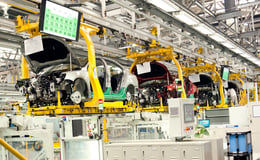5 Ways to Save Costs in the Truck/Automotive Supply Chain
Brian Hoey - October 06, 2020

 Cost pressures on manufacturers of commercial vehicles have been increasing for years, and the coronavirus crisis certainly isn’t making things any easier. Automakers and other supply chain players around the world are restarting their operations, only to find that reliable suppliers and partners have gone out of business, entire markets are still shut down, and consumer buying patterns have changed dramatically. Needless to say, anything you can do under these conditions to save costs and get more efficient is going to be of paramount importance.
Cost pressures on manufacturers of commercial vehicles have been increasing for years, and the coronavirus crisis certainly isn’t making things any easier. Automakers and other supply chain players around the world are restarting their operations, only to find that reliable suppliers and partners have gone out of business, entire markets are still shut down, and consumer buying patterns have changed dramatically. Needless to say, anything you can do under these conditions to save costs and get more efficient is going to be of paramount importance.
Of course, if it were easy to reduce costs and improve your margins without increasing your risk to an unacceptable level, everyone would do it. But most sustainable measures in this area require you to rethink many of the systems, processes, and networks that underpin your existing operations. This can present some challenges, but as we’ll show below, the payoff can be considerable for companies that are willing and able to capitalize on modern advances in digitization and analytics.
1. Increase Productivity
Okay, let’s state the obvious for a second: you can save costs by increasing your productivity. More specifically, you can improve our cost efficiency by at least 5-10% by increasing throughput and avoiding rework and parts outages. “That’s all well and good,” you might be thinking, “but how do you make that happen?” As with many of the items on this list, it begins with gaining visibility into your value chain: Instead of planning production flows with pen and ink or Excel spreadsheets, start with a smart, digital interface that can take in information about the parameters, restrictions, and requirements for individual products, production lines, and orders. This is your first step towards powering slotting, sequencing, and scheduling processes that are optimized by advanced analytics—which will ultimately empower you to visualize the likely outcomes across different planning horizons, select the optimal choice, and then perform lightning-fast replannings if conditions change. By creating plans that are visible and adaptable in this way, you can increase the stability of your production chain overall and reduce the kinds of disruptions that can often prove costly.
2. Reduce Capital Commitments
Like we said, you’re ultimately going to want to rethink all of the structures and processes that underpin your operations, which means that improvements in cost efficiency will have a tendency to cascade. To wit, if you’re using a smart, digital production planning module that helps you to avoid missing parts and time-consuming rework, you can also begin to reduce your lead times. With reduced lead times, you can reduce your inventory needs—potentially by as much as 20%. In this way, you’re able to reduce your capital commitments, which gives you the ability to be more flexible at every touchpoint on the value chain. In turn, this added flexibility has the potential to help you build out more dynamic processes and structures across the board, yielding even more opportunities for cost optimization down the road.
3. Adjust Capacities Dynamically
In the past, most logistics routes tended to be fixed well ahead of time, and transport planners would rely on those same routes year in and year out to get their goods from the production plant to the warehouse to the showroom. Though in a pre-Logistics 4.0 environment this was often the only practical option, this kind of process makes it impossible to actually secure the best rates along the most sensible routes on an ongoing basis. Now it’s possible to reroute logistics flows dynamically based on emerging market conditions—meaning that you can wait to lock in the right capacities on the right routes at the right prices. How do you make this a reality? First, you need to connect datastreams from up and downstream in the supply chain to a centralized transport planning module that’s integrated with your other technology in such a way as to promote visibility. Combine this with advanced predictive analytics that help you identify pricing and routing trends in real-time, and all of a sudden you can visualize the best option based on your needs and parameters. Since this helps you avoid overpaying for transport capacities—just as it helps you avoid over-reliance on sub-optimal routes—it can be a catalyst for cost savings of 10-20%.
4. Expect the Unexpected
So far, we’ve painted a picture of connectivity, real-time data integration, and analytics-driven planning as the best way forward for managing costs in the automotive supply chain. This might seem difficult to achieve, but in point of fact it’s just a matter of prioritizing the right IT and processes. What defines the right IT and processes? Simply put, a commitment to increasing transparency, digitization, and connectivity, such that silos are rooted out and data travels freely from point to point. If you’re able to keep this in mind over the course of your digital transformation, you can fight off cost pressures through proactive planning and scheduling in a variety of different areas. In fact, you can get so proactive that the frequency with which you're scrambling to get a car or truck produced or shipped on a seemingly-impossible deadline will decline precipitously. This, as it happens, is another way to reduce costs on an ongoing basis: unplanned special promotions, special trips, premium freight, special meetings, and task forces for unexpected situations—all of these things can create significant unwanted costs. When you reduce lead times and inventory and maintain a high degree of real operational agility, you can cut down on these kinds of expenses by 90%.
5. Migrate to the Cloud
For most supply chains, the kinds of cost optimizations we’ve been discussing will require some new IT—making this the perfect time to revisit your IT costs. Heavy, monolithic on-site IT infrastructure was the norm for decades, but in the modern IT landscape you’re potentially much better off with more modular, heterogenous software that’s hosted in the cloud. Not only does this give you the chance to root out redundant systems, it also puts you in a position to cut your internal IT costs—potentially by as much as 30%. Considering that, when implemented correctly, these cloud-based supply chain management systems can also pave the way for exactly the sorts of cost-saving tactics we’ve been talking about all along, the fact that they also represent a way to decrease IT costs is just icing on the cake.
LATEST POSTS
- Understand Circular Economy in The Manufacturing Industry
- How Can Industry 4.0 IT Integration Be Achieved Smoothly?
- The Significance of Order Sequencing in Discrete Manufacturing
- How to improve your Supply Chain Management: The Power of Control Towers
- Optimizing Human Resource Scheduling in Manufacturing: A Technological Approach



